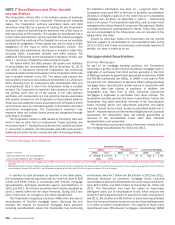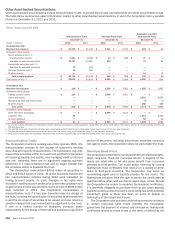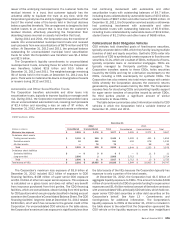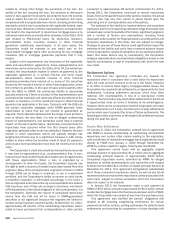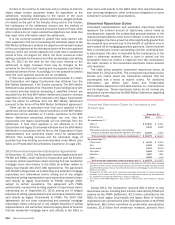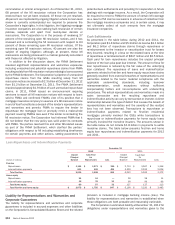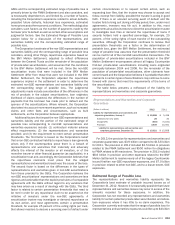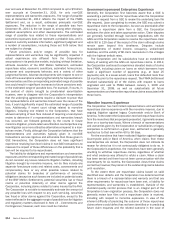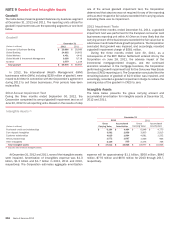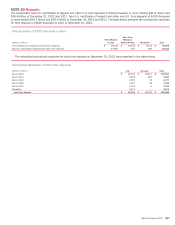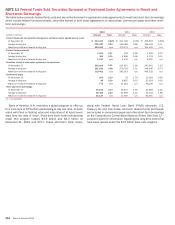Bank of America 2012 Annual Report Download - page 210
Download and view the complete annual report
Please find page 210 of the 2012 Bank of America annual report below. You can navigate through the pages in the report by either clicking on the pages listed below, or by using the keyword search tool below to find specific information within the annual report.208 Bank of America 2012
related to, among other things, the ownership of the loan, the
validity of the lien securing the loan, the absence of delinquent
taxes or liens against the property securing the loan, the process
used to select the loan for inclusion in a transaction, the loan’s
compliance with any applicable loan criteria, including underwriting
standards, and the loan’s compliance with applicable federal, state
and local laws. Breaches of these representations and warranties
may result in the requirement to repurchase mortgage loans or to
otherwise make whole or provide other remedies to the GSEs, HUD
with respect to FHA-insured loans, VA, whole-loan investors,
securitization trusts, monoline insurers or other financial
guarantors (collectively, repurchases). In all such cases, the
Corporation would be exposed to any credit loss on the
repurchased mortgage loans after accounting for any mortgage
insurance (MI) or mortgage guarantee payments that it may
receive.
Subject to the requirements and limitations of the applicable
sales and securitization agreements, these representations and
warranties can be enforced by the GSEs, HUD, VA, the whole-loan
investor, the securitization trustee or others as governed by the
applicable agreement or, in certain first-lien and home equity
securitizations where monoline insurers or other financial
guarantee providers have insured all or some of the securities
issued, by the monoline insurer or other financial guarantor, where
the contract so provides. In the case of loans sold to parties other
than the GSEs or GNMA, the contractual liability to repurchase
typically arises only if there is a breach of the representations and
warranties that materially and adversely affects the interest of the
investor, or investors, or of the monoline insurer or other financial
guarantor (as applicable) in the loan. Contracts with the GSEs do
not contain equivalent language, while GNMA generally limits
repurchases to loans that are not insured or guaranteed as
required. The Corporation believes that the longer a loan performs
prior to default, the less likely it is that an alleged underwriting
breach of representations and warranties would have a material
impact on the loan’s performance. Historically, most demands for
repurchase have occurred within the first several years after
origination, generally after a loan has defaulted. However, the time
horizon in which repurchase claims are typically brought has
lengthened primarily due to a significant increase in GSE claims
related to loans where the borrower made at least 25 payments
and to loans that had defaulted more than 18 months prior to the
claim.
The Corporation’s credit loss would be reduced by any recourse
it may have to organizations (e.g., correspondents) that, in turn,
had sold such loans to the Corporation based upon its agreements
with these organizations. When a loan is originated by a
correspondent or other third party, the Corporation typically has
the right to seek a recovery of related repurchase losses from that
originator. Many of the correspondent originators of loans in 2004
through 2008 are no longer in business, or are in a weakened
condition, and the Corporation’s ability to recover on valid claims
is therefore impacted, or eliminated accordingly. In the event a
loan is originated and underwritten by a correspondent who obtains
FHA insurance, even if they are no longer in business, any breach
of FHA guidelines is the direct obligation of the correspondent, not
the Corporation. Generally the volume of unresolved repurchase
claims from the FHA and VA for loans in GNMA-guaranteed
securities is not significant because the requests are limited in
number and are typically resolved quickly. At December 31, 2012,
approximately 26 percent of the outstanding repurchase claims
relate to loans purchased from correspondents or other parties
compared to approximately 28 percent at December 31, 2011.
During 2012, the Corporation continued to recover repurchase
losses from correspondents and other parties; however, the actual
recovery rate may vary from period to period based upon the
underlying mix of correspondents and other parties.
The estimate of the liability for representations and warranties
exposures and the corresponding estimated range of possible loss
is based upon currently available information, significant judgment,
and a number of factors and assumptions, including those
discussed under Liability for Representations and Warranties and
Corporate Guarantees in this Note, that are subject to change.
Changes to any one of these factors could significantly impact the
estimate of the liability and could have a material adverse impact
on the Corporation’s results of operations for any particular period.
Given that these factors vary by counterparty, the Corporation
analyzes representations and warranties obligations based on the
specific counterparty, or type of counterparty, with whom the sale
was made.
Settlement Actions
The Corporation has vigorously contested any request for
repurchase when it concludes that a valid basis for repurchase
does not exist and will continue to do so in the future. However,
in an effort to resolve these legacy mortgage-related issues, the
Corporation has reached bulk settlements, or agreements for bulk
settlements, including settlement amounts which have been
material, with counterparties in lieu of a loan-by-loan review
process. The Corporation may reach other settlements in the future
if opportunities arise on terms it believes to be advantageous.
However, there can be no assurance that the Corporation will reach
future settlements or, if it does, that the terms of past settlements
can be relied upon to predict the terms of future settlements. The
following provides a summary of the larger bulk settlement actions
during the past few years.
Fannie Mae Settlement
On January 6, 2013, the Corporation entered into an agreement
with FNMA to resolve substantially all outstanding and potential
repurchase and certain other claims relating to the origination,
sale and delivery of residential mortgage loans originated and sold
directly to FNMA from January 1, 2000 through December 31,
2008 by entities related to legacy Countrywide and BANA.
This agreement covers loans with an aggregate original
principal balance of approximately $1.4 trillion and an aggregate
outstanding principal balance of approximately $300 billion.
Unresolved repurchase claims submitted by FNMA for alleged
breaches of selling representations and warranties with respect
to these loans totaled $12.2 billion of unpaid principal balance at
December 31, 2012. This agreement extinguished substantially
all of those unresolved repurchase claims, as well as any future
representations and warranties repurchase claims associated with
such loans, subject to certain exceptions which the Corporation
does not expect to be material.
In January 2013, the Corporation made a cash payment to
FNMA of $3.6 billion and also repurchased for $6.6 billion certain
residential mortgage loans that had previously been sold to FNMA,
which the Corporation has valued at less than the purchase price.
This agreement also clarified the parties’ obligations with
respect to MI including establishing timeframes for certain
payments and other actions, setting parameters for potential bulk
settlements and providing for cooperation in future dealings with




